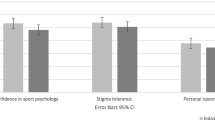Abstract
Match fixing represents a major threat to sport integrity and action is needed to tackle this phenomenon across levels and types of sport. The present study examined, for the first time, the psychological factors associated with athletes’ intentions to engage in match fixing, by utilizing the Theory of Planned Behaviour. Ninety nine athletes from team sports (M = 21.98 years, SD = 2.25) participated in the study and completed a survey measuring the variables of TPB (i.e., attitudes, subjective norms, perceived behavioural control, and intentions). The results of the analyses indicated that approximately 30% of the athletes reported that have been engaged in a match that they believe was fixed, and intentions to engage in match fixing were significantly associated with perceived social approval of match fixing among referent others. Further analysis showed that athletes with prior experience of match fixing also perceived stronger social norms in favor of match fixing as compared to athletes without such experience. Our findings are novel and have implications about the role of social norms in understanding and preventing match fixing in sport, and we provide specific recommendation for future studies and policy-making in this area.
Similar content being viewed by others
References
Carpenter, K. (2012). Match-fixing: The biggest threat to sport in the 21st century? International Sport in Law Review, 2, 13–24.
Harvey, A., & Levi, H. (2014). Don’t fix it. Players Questionnaire – Results & Analysis. FIFPro/Birkbeck.
Ajzen, I. (1991). The theory of planned behaviour. Organizational Behaviour and Human Decision Processes, 50(2), 179–211.
Armitage, C. J., & Conner, M. (2001). Efficacy of the theory of planned behaviour: A meta-analytic review. British Journal of Social Psychology, 40(4), 471–499.
Conner, M., & Armitage, C. J. (1998). Extending the theory of planned behaviour: A review and avenues for further research. Journal of Applied Social Psychology, 28(15), 1429–1464.
Fishbein, M., & Ajzen, I. (2011). Predicting and changing behaviour: The reasoned action approach. New York: Psychology Press.
Beck, L., & Ajzen, I. (1991). Predicting dishonest actions using the theory of planned behaviour. Journal of Research in Personality, 25(3), 285–301.
Bobek, D. D., & Hatfield, R. C. (2003). An investigation of the theory of planned behaviour and the role of moral obligation in tax compliance. Behavioural Research in Accounting, 15(1), 13–38.
Chudzicka-Czupała, A., Grabowski, D., Mello, A. L., Kuntz, J., Zaharia, D. V., Hapon, N., et al. (2016). Application of the theory of planned behaviour in academic cheating research–cross-cultural comparison. Ethics & Behaviour, 26(8), 638–659.
Stone, T. H., Jawahar, I. M., & Kisamore, J. L. (2009). Using the theory of planned behaviour and cheating justifications to predict academic misconduct. Career Development International, 14(3), 221–241.
Ntoumanis, N., Ng, J. Y., Barkoukis, V., & Backhouse, S. (2014). Personal and psychosocial predictors of doping use in physical activity settings: A meta-analysis. Sports Medicine, 44(11), 1603–1624.
Pallant, J. (2013). SPSS survival manual. London: McGraw-Hill Education.
Forrest, D. (2012). The threat to football from betting-related. International Journal of Sport Finance, 7(2), 99–116.
McEachan, R. R. C., Conner, M., Taylor, N. J., & Lawton, R. J. (2011). Prospective prediction of health-related behaviours with the theory of planned behaviour: A meta-analysis. Health Psychology Review, 5(2), 97–144.
Manning, M. (2009). The effects of subjective norms on behaviour in the theory of planned behaviour: A meta-analysis. British Journal of Social Psychology, 48(4), 649–705.
Lapinski, M. K., & Rimal, R. N. (2005). An explication of social norms. Communication Theory, 15(2), 127–147.
Rimal, R. N., & Real, K. (2005). How behaviours are influenced by perceived norms: A test of the theory of normative social behaviour. Communication Research, 32(3), 389–414.
Rimal, R. N., & Lapinski, M. K. (2015). A re-explication of social norms, ten years later. Communication Theory, 25(4), 393–409.
Cialdini, R. B., Kallgren, C. A., & Reno, R. R. (1991). A focus theory of normative conduct: A theoretical refinement and reevaluation of the role of norms in human behaviour. In Advances in experimental social psychology (Vol. 24, pp. 201–234). New York: Academic Press.
Kallgren, C. A., Reno, R. R., & Cialdini, R. B. (2000). A focus theory of normative conduct: When norms do and do not affect behaviour. Personality and Social Psychology Bulletin, 26(8), 1002–1012.
Schultz, P. W., Nolan, J. M., Cialdini, R. B., Goldstein, N. J., & Griskevicius, V. (2007). The constructive, destructive, and reconstructive power of social norms. Psychological Science, 18(5), 429–434.
Cialdini, R. B. (2007). Descriptive social norms as underappreciated sources of social control. Psychometrika, 72(2), 263–268.
Author information
Authors and Affiliations
Corresponding author
Additional information
Publisher’s note
Springer Nature remains neutral with regard to jurisdictional claims in published maps and institutional affiliations.
Rights and permissions
About this article
Cite this article
Barkoukis, V., Lazuras, L. & Kourelis, P. A preliminary investigation of the decision making process towards match fixing. Crime Law Soc Change 74, 45–54 (2020). https://doi.org/10.1007/s10611-019-09870-5
Published:
Issue Date:
DOI: https://doi.org/10.1007/s10611-019-09870-5




